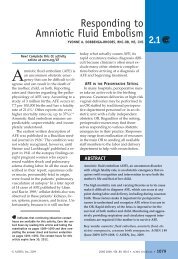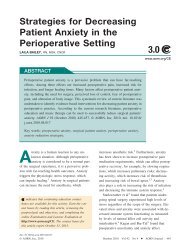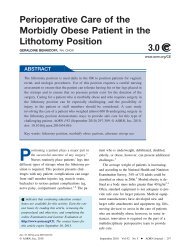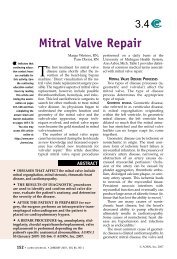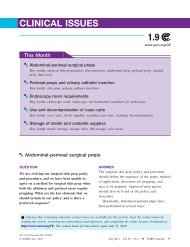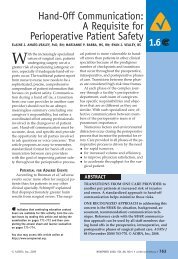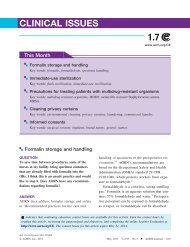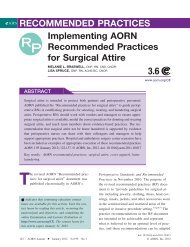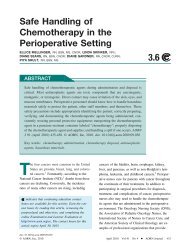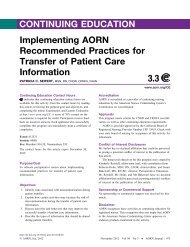Implementing AORN Recommended Practices for Product Selection
Implementing AORN Recommended Practices for Product Selection
Implementing AORN Recommended Practices for Product Selection
You also want an ePaper? Increase the reach of your titles
YUMPU automatically turns print PDFs into web optimized ePapers that Google loves.
CONTINUING EDUCATION<br />
<strong>Implementing</strong> <strong>AORN</strong><br />
<strong>Recommended</strong> <strong>Practices</strong><br />
<strong>for</strong> <strong>Product</strong> <strong>Selection</strong><br />
JULIE A. CONRARDY, MSN, RN, CNOR, CNS-BC<br />
Continuing Education Contact Hours<br />
indicates that continuing education contact hours are<br />
available <strong>for</strong> this activity. Earn the contact hours by reading<br />
this article, reviewing the purpose/goal and objectives, and<br />
completing the online Examination and Learner Evaluation<br />
at http://www.aorn.org/CE. A score of 70% correct on the<br />
examination is required <strong>for</strong> credit. Participants receive feedback<br />
on incorrect answers. Each applicant who successfully<br />
completes this program can immediately print a certificate of<br />
completion.<br />
Event: #12517<br />
Session: #0001<br />
Fee: Members $13.50, Nonmembers $27<br />
The contact hours <strong>for</strong> this article expire June 30, 2015.<br />
Purpose/Goal<br />
To educate perioperative nurses about how to implement the<br />
<strong>AORN</strong> “<strong>Recommended</strong> practices <strong>for</strong> product selection in<br />
perioperative practice settings.”<br />
Objectives<br />
1. Discuss <strong>AORN</strong>’s practice recommendations <strong>for</strong> product<br />
selection and evaluation.<br />
2. Identify the benefits of implementing a multidisciplinary<br />
product selection and evaluation team.<br />
3. Discuss methods <strong>for</strong> implementing <strong>AORN</strong>’s practice<br />
recommendations <strong>for</strong> product selection.<br />
Accreditation<br />
<strong>AORN</strong> is accredited as a provider of continuing nursing<br />
education by the American Nurses Credentialing Center’s<br />
Commission on Accreditation.<br />
2.7<br />
www.aorn.org/CE<br />
Approvals<br />
This program meets criteria <strong>for</strong> CNOR and CRNFA<br />
recertification, as well as other continuing education<br />
requirements.<br />
<strong>AORN</strong> is provider-approved by the Cali<strong>for</strong>nia Board of<br />
Registered Nursing, Provider Number CEP 13019. Check with<br />
your state board of nursing <strong>for</strong> acceptance of this activity <strong>for</strong><br />
relicensure.<br />
Conflict of Interest Disclosures<br />
LCDR Conrardy has no declared affiliation that could be<br />
perceived as posing a potential conflict of interest in the<br />
publication of this article.<br />
The behavioral objectives <strong>for</strong> this program were created<br />
by Kimberly Retzlaff, editor/team lead, with consultation<br />
from Rebecca Holm, MSN, RN, CNOR, clinical editor,<br />
and Susan Bakewell, MS, RN-BC, director, Perioperative<br />
Education. Ms Retzlaff, Ms Holm, and Ms Bakewell have<br />
no declared affiliations that could be perceived as posing<br />
potential conflicts of interest in the publication of this<br />
article.<br />
Sponsorship or Commercial Support<br />
No sponsorship or commercial support was received <strong>for</strong><br />
this article.<br />
Disclaimer<br />
<strong>AORN</strong> recognizes these activities as continuing education <strong>for</strong><br />
registered nurses. This recognition does not imply that <strong>AORN</strong><br />
or the American Nurses Credentialing Center approves or<br />
endorses products mentioned in the activity.<br />
doi: 10.1016/j.aorn.2012.04.001<br />
788 j <strong>AORN</strong> Journal June 2012 Vol 95 No 6 Published by Elsevier, Inc., on behalf of <strong>AORN</strong>, Inc.
RECOMMENDED PRACTICES<br />
ABSTRACT<br />
<strong>Implementing</strong> <strong>AORN</strong><br />
<strong>Recommended</strong> <strong>Practices</strong><br />
<strong>for</strong> <strong>Product</strong> <strong>Selection</strong><br />
JULIE A. CONRARDY, MSN, RN, CNOR, CNS-BC 2.7<br />
This article focuses on the revised <strong>AORN</strong> “<strong>Recommended</strong> practices <strong>for</strong> product<br />
selection in perioperative practice settings.” Hospitals and ambulatory surgery<br />
facilities should have protocols in place <strong>for</strong> product evaluation that includes<br />
a multidisciplinary team approach. The process <strong>for</strong> product evaluation and selection<br />
includes gathering in<strong>for</strong>mation; establishing consistent requirements <strong>for</strong> product<br />
evaluation; per<strong>for</strong>ming a financial impact analysis; investigating a plan to standardize<br />
products; conducting an environmental impact analysis; determining<br />
whether to purchase single-use, reposable, or reusable products or reprocess singleuse<br />
devices; developing an evaluation process based on objective criteria; and<br />
developing and implementing a comprehensive plan to introduce and use new<br />
products. Use of an evaluation tool that is based on objective criteria is one way to<br />
obtain valuable input during product evaluations. Because of varied roles and<br />
experiences, the perioperative RN is an integral member of the product selection<br />
committee. <strong>AORN</strong> J 95 (June 2012) 789-800. Published by Elsevier, Inc., on behalf<br />
of <strong>AORN</strong>, Inc. doi: 10.1016/j.aorn.2012.04.001<br />
Key words: <strong>AORN</strong> recommended practices, product selection, product evaluation,<br />
multidisciplinary team, environmental impact.<br />
<strong>Product</strong> selection is not as simple as acquiring<br />
a new product, trying it out in the perioperative<br />
setting, asking one provider’s<br />
opinion, and then determining whether a facility<br />
will use it. The purpose of the <strong>AORN</strong> “<strong>Recommended</strong><br />
practices <strong>for</strong> product selection in perioperative<br />
practice settings” is to “provide guidelines <strong>for</strong><br />
evaluating and purchasing medical devices and<br />
www.aorn.org/CE<br />
other products used in perioperative settings.” 1(p191)<br />
There are six recommendations that will assist perioperative<br />
nurses in selecting appropriate products<br />
<strong>for</strong> use in the perioperative arena. The following<br />
article is by no means a “how-to” guide, but<br />
rather a discussion of the recommended practices<br />
that is intended to assist readers in following the<br />
steps from the beginning to the end of the product<br />
doi: 10.1016/j.aorn.2012.04.001<br />
Published by Elsevier, Inc., on behalf of <strong>AORN</strong>, Inc. June 2012 Vol 95 No 6 <strong>AORN</strong> Journal j 789
June 2012 Vol 95 No 6 CONRARDY<br />
selection process and implementing a multidisciplinary<br />
team approach to product selection.<br />
WHAT’S NEW?<br />
The newly updated recommended practices (RP)<br />
document was first published electronically in<br />
January 2010 in <strong>AORN</strong>’s Perioperative Standards<br />
and <strong>Recommended</strong> <strong>Practices</strong>. The most significant<br />
changes from the previous version, which was first<br />
published in 2004, are more detailed descriptions<br />
of the requirements <strong>for</strong> establishing a multidisciplinary<br />
team that represents the facility and the<br />
requirement that perioperative RNs demonstrate<br />
competency related to product evaluation and<br />
selection.<br />
Multidisciplinary teams are not static, but rather<br />
ever changing. The composition of the committee<br />
changes based on the products being evaluated.<br />
Perioperative nurses are essential participants <strong>for</strong><br />
product evaluations because they are in the unique<br />
position to provide end-user input as well as<br />
patient feedback on many products. Perioperative<br />
nurses are natural leaders and should understand<br />
the importance of showing and maintaining<br />
competency related to product and equipment<br />
Educational Resources<br />
n The Role of the Perioperative Nurse in <strong>Product</strong> Evaluation and<br />
<strong>Selection</strong>. http://www.aorn.org/Education/Specialty_Education/<br />
<strong>Product</strong>_Evaluation_and_<strong>Selection</strong>_Course.aspx.<br />
n Perioperative Management Resources: Evaluation of New<br />
Technology. Denver, CO: <strong>AORN</strong>, Inc; 2005. http://www.aorn<br />
bookstore.org//product/product.asp?sku¼MAN376.<br />
n <strong>Product</strong> selection. In: Policy and Procedures Templates [CD-<br />
ROM]. 2nd ed. Denver, CO: <strong>AORN</strong>, Inc; 2010. http://www<br />
.aorn.org/Books_and_Publications/<strong>AORN</strong>_Publications/Policy_<br />
and_Procedure_Templates.aspx.<br />
n <strong>AORN</strong> position statement on environmental responsibility.<br />
http://www.aorn.org/Clinical_Practice/Position_Statements/<br />
Position_Statements.aspx.<br />
Web site access verified February 16, 2012.<br />
790 j <strong>AORN</strong> Journal<br />
usage to help promote patient safety. Establishing<br />
a consistent method <strong>for</strong> product evaluation will<br />
streamline the process and help eliminate wasted<br />
time and ef<strong>for</strong>t.<br />
The RP also highlights the need <strong>for</strong> contractual<br />
agreements, financial analysis, product requirements,<br />
environmental impact, an evaluation<br />
process, and an implementation process if products<br />
are selected. Additionally, the revised RP provides<br />
guidance on measuring quality assurance and process<br />
improvement, as well as establishing and<br />
maintaining user competency and continued<br />
training and education on selected products.<br />
RATIONALE<br />
The perioperative practice setting, be it a large<br />
hospital or a busy ambulatory facility, is the<br />
optimal location <strong>for</strong> assessing new products.<br />
“Innovations in procedures and technology are<br />
drivers of perioperative practice, and nurses in<br />
particular must find ways to incorporate new<br />
products into the perioperative setting.” 2(p334) The<br />
varied expertise of perioperative RNsdas leaders,<br />
educators, infection prevention professionals,<br />
researchers, and patient advocates, to name a<br />
fewdplaces them in<br />
a unique position to effectively<br />
integrate and evaluate<br />
products based on standards<br />
of safety and quality of<br />
patient care. 2<br />
Perioperative RNs<br />
develop an extensive<br />
working knowledge of<br />
surgical procedures,<br />
processes, and outcomes <strong>for</strong><br />
each procedure in which<br />
they are involved, and they<br />
can become well versed in<br />
the complete and complex<br />
perioperative experiences<br />
of patients from beginning to<br />
end. This puts them in an<br />
ideal position to offer critical
RP IMPLEMENTATION GUIDE: PRODUCT SELECTION www.aornjournal.org<br />
and timely feedback based on evidence-based<br />
practice and provider experience with<br />
many products.<br />
In today’s economically challenging environment,<br />
facility administrators and other personnel<br />
are looking <strong>for</strong> ways to “trim the fat” from budgets<br />
across the board. Some are quick to say that there<br />
is no price too high to put on patient safety, and<br />
they are correct; however, perioperative RNs have<br />
a fiscal responsibility as well and must participate<br />
in the process <strong>for</strong> evaluating and selecting the<br />
best quality products that will ensure both costeffectiveness<br />
and patient safety. “All health care<br />
organizations should have processes to evaluate<br />
purchases of new products.” 3(p782) If product evaluation<br />
and selection are made through a thorough<br />
systematic approach, then outcomes will contribute<br />
to safe patient care, consumer satisfaction, and cost<br />
containment.<br />
DISCUSSION<br />
<strong>Product</strong> selection is often complex, but with an<br />
established process in place, it can be simplified. In<br />
this section, each recommendation from the RP<br />
document will be discussed briefly, with emphasis<br />
on the perioperative RN’s role, potential barriers to<br />
implementation, and strategies <strong>for</strong> overcoming<br />
these barriers to ultimately establish successful<br />
implementation.<br />
Recommendation I<br />
Health care facilities should have an established<br />
mechanism <strong>for</strong> product selection in place, but<br />
because the surgical arena is never a static environment,<br />
there is always a need <strong>for</strong> process improvement.<br />
A multidisciplinary team should be<br />
established to guide process improvement and<br />
product selection.<br />
A multidisciplinary team is “a group composed<br />
of members with varied but complementary experience,<br />
qualifications, and skills that contribute<br />
to the achievement of the organization’s specific<br />
objectives.” 4 Depending on the size of the facility,<br />
the team should be all encompassing, with particular<br />
regard to the end users of the products. It is<br />
important to include the end users in the product<br />
evaluation process so they have an equal say in the<br />
suitability of the products being considered. If<br />
there is no consideration given to the end users<br />
or they are unwilling to participate in product<br />
evaluations, a product could be purchased that may<br />
not meet their needs or the needs of the patients.<br />
This could lead to products being wasted or<br />
underused, which can become a financial burden<br />
on the facility.<br />
The perioperative RN is an integral component<br />
of the evaluation and selection process. The role<br />
of the perioperative RN is constantly evolving<br />
and is indeed dynamic, and perioperative RNs are<br />
well versed in the preoperative, intraoperative,<br />
and postoperative phases of the surgical experience.<br />
The varied and dynamic role, as well as<br />
the need to work with many different ancillary<br />
services in a given day, makes the perioperative<br />
RN an ideal participant on the product selection<br />
team.<br />
The perioperative RN must be willing to advocate<br />
<strong>for</strong> safe, effective, efficient, and environmentally<br />
friendly products and equipment <strong>for</strong> the<br />
product evaluation to be a worthwhile process. 1<br />
Advocacy is demonstrated by volunteering and<br />
following up regarding the desire to participate<br />
in product evaluations. This responsibility rests<br />
on the RN’s shoulders, but the following factors<br />
may prevent perioperative RNs from being a part of<br />
the multidisciplinary team:<br />
n unavailability because of workload;<br />
n lack of interest or knowledge in the process;<br />
n timing of the review and evaluation process (eg,<br />
if the review is scheduled <strong>for</strong> a day when the<br />
nurse is not working or during the day when the<br />
nurse works nights); or<br />
n the need to conduct multiple reviews simultaneously,<br />
which may create confusion.<br />
These potential pitfalls can be overcome by the end<br />
users asking the individuals on the multidisciplinary<br />
<strong>AORN</strong> Journal j 791
June 2012 Vol 95 No 6 CONRARDY<br />
Figure 1. The product review process requires full commitment from the RN to see it through to completion.<br />
team questions about the products, the process, and<br />
any concerns that they might have. It is important<br />
<strong>for</strong> nurses to in<strong>for</strong>m their facility leaders if they are<br />
interested in participating in the product evaluation<br />
process and providing them with as much advanced<br />
notice as possible to assist the leaders in covering<br />
the workload.<br />
At my facility, the process is not cumbersome<br />
but does require full commitment on the<br />
RN’s part to see the process through to completion<br />
(Figure 1). <strong>Product</strong> selection is not just the<br />
process of suggesting that a new product be added<br />
to the ordering system at a facility, but includes<br />
asking facility leaders about the existing product<br />
evaluation policy, how to start the process of<br />
presenting a product or piece of equipment <strong>for</strong><br />
evaluation, and how the nurse can participate on<br />
the team.<br />
Recommendation II<br />
After the perioperative RN becomes a member of<br />
the multidisciplinary committee, he or she will<br />
work with the team to develop a process to guide<br />
product selection. The product selection process<br />
includes gathering in<strong>for</strong>mation; establishing consistent<br />
requirements <strong>for</strong> each product under evaluation;<br />
per<strong>for</strong>ming a financial impact analysis;<br />
investigating a plan to standardize products across<br />
the facility; conducting an environmental impact<br />
analysis; determining whether to purchase single-<br />
792 j <strong>AORN</strong> Journal<br />
use, reposable, or reusable products; determining<br />
whether to reprocess single-use devices; developing<br />
an evaluation process based on objective<br />
criteria; and developing and implementing<br />
a comprehensive plan to introduce and use<br />
new products.<br />
In<strong>for</strong>mation gathering. The first step is to<br />
gather in<strong>for</strong>mation about products and equipment.<br />
In<strong>for</strong>mation gathering can be fairly easy when<br />
a specific product or piece of equipment is being<br />
evaluated. The perioperative RN is frequently the<br />
catalyst <strong>for</strong> this process. This first step usually<br />
occurs when someone asks the nurse a question<br />
about a particular product or in<strong>for</strong>mation is found<br />
in a brochure. This question or discovery then<br />
triggers the process of researching the item. This<br />
research can be accomplished by searching the<br />
Internet or contacting a vendor, or through<br />
hands-on evaluation at a vendor show or in<br />
another facility.<br />
Consistent requirements. The committee<br />
members should identify consistent requirements<br />
<strong>for</strong> each new technology or product that is under<br />
review. This part of the process can be daunting<br />
because team members who have different requirements<br />
have to evaluate and develop criteria<br />
together. However, this step is essential because it<br />
helps to eliminate products and equipment that do<br />
not meet the needs of the facility, patients, and<br />
staff members.
RP IMPLEMENTATION GUIDE: PRODUCT SELECTION www.aornjournal.org<br />
The process of creating consistent requirements<br />
is certainly more cumbersome when evaluating<br />
a product like gloves because there are so many<br />
choices available, and different team members<br />
request different criteria. For example, the perioperative<br />
nurse would evaluate all-purpose gloves<br />
<strong>for</strong> a good fit and nonpermeable material <strong>for</strong><br />
protection during cleaning, whereas an infection<br />
prevention professional would want the gloves to fit<br />
well, especially in the fingers <strong>for</strong> providers who are<br />
involved in more precise, intricate work like<br />
placing IV lines.<br />
The perioperative RN is an excellent resource<br />
<strong>for</strong> identifying new products specific to surgical<br />
patient care but must<br />
keep in mind factors<br />
such as compatibility<br />
with current equipment,<br />
patient and staff<br />
member safety, environmental<br />
impact, and<br />
cost-effectiveness. Perioperative RNs are familiar<br />
with many different equipment systems already<br />
in place at their facilities and have access to<br />
companies and their representatives who can<br />
readily provide in<strong>for</strong>mation on the compatibility,<br />
cost, and safety of many products. The Internet<br />
is also a great resource <strong>for</strong> comparing product<br />
costs and finding in<strong>for</strong>mation on environmental<br />
impact. Team members also can poll other<br />
facilities in the area <strong>for</strong> in<strong>for</strong>mation on the<br />
products they use. This in<strong>for</strong>mation may be<br />
readily available from providers who work in<br />
multiple facilities in any given city. These<br />
providers can provide in<strong>for</strong>mation on products<br />
based on their experiences.<br />
Financial impact. The associated cost of<br />
acquiring a new product is always a concern.<br />
Hospitals and ambulatory facilities do not have<br />
unlimited budgets, so it is essential to consider the<br />
cost associated with introducing a new item to the<br />
supply system. It is essential that a representative<br />
from the finance department be involved in the<br />
multidisciplinary team from the beginning of the<br />
product evaluation process to assist with the<br />
financial analysis. This assistance is beneficial to<br />
the other team members who may not know how to<br />
complete the analysis. The perioperative nurse can<br />
assist by acquiring vendor quotes on the associated<br />
costs <strong>for</strong> new products and equipment, which is<br />
essential <strong>for</strong> the financial department to have <strong>for</strong><br />
a cost analysis.<br />
Standardization. When looking to procure<br />
new technology or products, the product selection<br />
team should consider standardization, which<br />
can reduce costs and may improve inventory<br />
control and use of storage space. 5-8 When referring<br />
to product evaluation,<br />
standardization can<br />
loosely be defined as<br />
a procurement agreement<br />
within a geographical<br />
region or<br />
between various<br />
groups within a facility pertaining to a certain<br />
product or product line. In the example of surgical<br />
gloves, there are many companies that provide this<br />
product. However, if there is a particular brand that<br />
a facility provides <strong>for</strong> surgeons, there may be other<br />
facilities within the same network that stock the<br />
brand. This opens up the opportunity to standardize<br />
acquisition of the same brand at all of the local<br />
network facilities. When proposing a product<br />
evaluation <strong>for</strong> multi-brand products (eg, gloves,<br />
cleaning supplies, dressings, tape), a standardization<br />
ef<strong>for</strong>t can work to the facility’s benefit. This<br />
principle also applies to purchasing a product<br />
within the facility. If the gloves are used by the<br />
OR personnel and not the radiology department<br />
personnel, there is a potential to benefit the facility<br />
if staff members in both departments agree to use<br />
thesamegloves.<br />
One potential challenge with gaining new<br />
products that have been standardized in a facility<br />
is what to do with the old products that are still<br />
in the supply rotation. This challenge may be<br />
A facility in the same network may stock a particular<br />
brand, which opens up the opportunity to<br />
standardize at all of the local network facilities.<br />
<strong>AORN</strong> Journal j 793
June 2012 Vol 95 No 6 CONRARDY<br />
overcome by developing a phasing-in plan. A<br />
well-developed phasing-in plan establishes a timeline<br />
guide <strong>for</strong> incorporating the new product into<br />
the supply system at the facility. Perioperative<br />
nurses can assist in this process by providing an<br />
accurate account of supplies that are still on hand<br />
in their work centers and helping to identify the<br />
amount of time needed to deplete the excess<br />
supplies while introducing the new standardized<br />
products. Adhering to the phasing-in plan ensures<br />
fiscal responsibility and gives consideration to<br />
decreasing the environmental impact by not<br />
wasting good supplies and adding to the<br />
waste stream.<br />
Environmental impact. To help assess the<br />
environmental impact, the product selection team<br />
should answer the following questions:<br />
n Can the product be recycled?<br />
n Is the product made of recycled materials?<br />
n What method is used <strong>for</strong> disposal?<br />
The answers can guide the team in making sound<br />
decisions <strong>for</strong> which products would be the most<br />
beneficial <strong>for</strong> a product evaluation.<br />
Consumers are very conscious of environmental<br />
concerns associated with the health care industry<br />
and the impact of waste. Various regulatory agencies<br />
(eg, state and county agencies) can assist teams<br />
in determining whether products are recyclable.<br />
These agencies frequently provide or assist in developing<br />
programs <strong>for</strong> managing recyclable items,<br />
such as plastic bottles.<br />
Single-use, reposable, and reusable<br />
products. <strong>Product</strong> selection teams must take<br />
into account whether they want to evaluate and<br />
possibly purchase single-use, reposable, or reusable<br />
items, all while considering efficiency, cost, the<br />
environment, and patient and personnel safety.<br />
Reusing, repairing, and refurbishing products can<br />
lead to a large reduction in the annual amount of<br />
waste generated at a health care organization. 9,10<br />
<strong>Product</strong>s that have a short shelf life or will be used<br />
only infrequently may be less desirable products <strong>for</strong><br />
794 j <strong>AORN</strong> Journal<br />
evaluation because they may be outdated be<strong>for</strong>e<br />
they are used.<br />
Reprocessing single-use devices. Potential<br />
cost savings created by reprocessing single-use<br />
devices can be a determining factor during product<br />
evaluation. Of course, all criteria <strong>for</strong> reprocessing<br />
must be addressed be<strong>for</strong>e the evaluation process<br />
can begin. Questions that the team should ask<br />
include the following:<br />
n Is the product on the list of approved reprocessed<br />
items from the US Food and Drug<br />
Administration (FDA)?<br />
n Is reprocessing cost-effective <strong>for</strong> the facility?<br />
Challenges to reusing products can vary from<br />
gaining provider or staff member buy-in to<br />
finding a qualified, FDA-approved processing<br />
company <strong>for</strong> reprocessing single-use items. A<br />
facility in which I worked in the past chose to<br />
pilot test reprocessed arthroscopic shavers. Some<br />
providers were not happy with the outcomes,<br />
and they stated that the reprocessing changed<br />
the dimensions of the original product so it did<br />
not work as well as a brand-new shaver. Ultimately,<br />
we chose not to reuse these products<br />
at the facility, even though the company was<br />
FDA-approved, because of staff member preferences.<br />
An example of a single-use product that<br />
was reprocessed and reused successfully at my<br />
<strong>for</strong>mer facility was sequential compression<br />
device sleeves.<br />
Evaluation process. It is important to use<br />
a consistent evaluation process to help ensure<br />
an objective review and analysis. 5,6,11 The<br />
evaluation process allows each team member to<br />
provide input based on his or her department’s<br />
requirements and needs. Involving team members<br />
from multidisciplinary departments with varying<br />
needs helps ensure the most appropriate products<br />
are selected to meet varying needs, 12 and<br />
involving personnel from multiple clinical areas<br />
helps garner direct feedback from those whose<br />
practice will be affected by the product. 5,13
RP IMPLEMENTATION GUIDE: PRODUCT SELECTION www.aornjournal.org<br />
Part of the evaluation process includes establishing<br />
and implementing the use of an evaluation<br />
tool. A product evaluation tool (Figure 2) should<br />
be simple to follow and easy to complete and<br />
should include product-specific criteria, including<br />
safety, per<strong>for</strong>mance, quality, efficiency, and ease<br />
of use, to name a few. 1 Having a well-defined<br />
multidisciplinary team will help ensure all of the<br />
technical questions about cost, usability, and safety<br />
are answered be<strong>for</strong>e the evaluation tool is developed.<br />
This assists the team members in creating an<br />
effective, streamlined tool based on objective<br />
criteria. As clinical experts and end users of the<br />
products, perioperative RNs have valuable input<br />
regarding what questions to ask when evaluating<br />
a product.<br />
Overall documentation of the selection and<br />
evaluation process must occur because it can<br />
provide additional in<strong>for</strong>mation to justify procuring<br />
the equipment or products or <strong>for</strong> negating the<br />
purchase as well. 1<br />
Documentation must<br />
remain objective and<br />
factual and not contain<br />
any opinions that may<br />
mar the data about<br />
specific products. This<br />
is a reason <strong>for</strong> the<br />
requirement of having<br />
an evaluation tool that is strictly objective<br />
in nature.<br />
Finding the right people to evaluate products<br />
objectively can be a potential challenge; some<br />
providers may not have the time to fill out evaluations,<br />
others may have a vested interest in particular<br />
products, and some providers are willing<br />
to use whatever product is provided as long as it<br />
does the specified job. These challenges can be<br />
overcome by establishing a plan ahead of time <strong>for</strong><br />
how to deal with each. For example, if the evaluators<br />
do not have time to complete the evaluation<br />
<strong>for</strong>m, the perioperative RN can assist by<br />
asking the questions out loud during the evaluation<br />
and recording the answers. Providing a space<br />
Challenges in introducing new products can<br />
occur when only one person is trained on the<br />
product and does not share the in<strong>for</strong>mation.<br />
This knowledge hoarding can be decreased<br />
by establishing a set number of trainers.<br />
<strong>for</strong> evaluators to disclose any vested interest in<br />
products being evaluated can protect the facility<br />
and the team from legal action. Finally, if evaluators<br />
do not have strong feelings about a particular<br />
product, it can be annotated on the comment<br />
section. Doing this provides documentation to<br />
support the decision in the event that issues arise<br />
later on, such as the original evaluator is discontented<br />
with the evaluated product.<br />
Introduction of new products. Another<br />
consideration that should be investigated during<br />
a product evaluation is how much education<br />
will be needed <strong>for</strong> end users of the product. It<br />
is essential that all end users be trained properly<br />
on all new products and equipment. Many vendors<br />
provide educational offerings related to their products.<br />
The education provided by the manufacturer<br />
allows the perioperative team to be well<br />
in<strong>for</strong>med on the particulars of certain products<br />
and equipment. It is<br />
important to remem-<br />
ber that education<br />
must be a continual<br />
process and not<br />
a one-time offering<br />
because of the<br />
dynamic and complex<br />
processes that occur<br />
in the perioperative arena. If the education<br />
becomes static and does not evolve with the<br />
technology, practitioners may develop shortcuts<br />
over time. The downside of using shortcuts<br />
ranges from malfunctioning equipment to<br />
situations in which patient or staff member safety<br />
is at risk.<br />
Challenges in introducing new products can<br />
occur when only one person is trained on the<br />
product and the person does not share the in<strong>for</strong>mation.<br />
This knowledge hoarding can be decreased<br />
when the multidisciplinary team members establish<br />
a set number of trainers. Designating more than<br />
one perioperative RN as a trainer eliminates the<br />
problem and allows <strong>for</strong> multiple people to maintain<br />
<strong>AORN</strong> Journal j 795
June 2012 Vol 95 No 6 CONRARDY<br />
Figure 2. A product evaluation tool should be simple to follow and easy to complete and should include productspecific<br />
criteria (eg, safety, ease of use, environmental impact).<br />
competency in the department. These trainers<br />
should provide education to new perioperative<br />
RNs.<br />
The Final Four<br />
The final four recommendations in each <strong>AORN</strong> RP<br />
document discuss education/competency, documentation,<br />
policies and procedures, and quality<br />
assurance/per<strong>for</strong>mance improvement. These four<br />
topics are integral to the implementation of<br />
<strong>AORN</strong> practice recommendations. Personnel<br />
should receive initial and ongoing education and<br />
796 j <strong>AORN</strong> Journal<br />
competency validation as applicable to their roles.<br />
<strong>Implementing</strong> new and updated recommended<br />
practices af<strong>for</strong>ds an excellent opportunity to create<br />
or update competency materials and validation<br />
tools. <strong>AORN</strong>’s perioperative competencies team<br />
has developed the <strong>AORN</strong> Perioperative Job<br />
Descriptions and Competency Evaluation Tools 14<br />
to assist perioperative personnel in developing<br />
competency evaluation tools and position<br />
descriptions.<br />
Documentation of nursing care should include<br />
patient assessment, plan of care, nursing diagnosis,
RP IMPLEMENTATION GUIDE: PRODUCT SELECTION www.aornjournal.org<br />
and identification of desired outcomes and interventions,<br />
as well as an evaluation of the patient’s<br />
response to care. <strong>Implementing</strong> new or updated<br />
recommended practices may warrant a review or<br />
revision of the relevant documentation being used<br />
in the facility.<br />
Policies and procedures should be developed,<br />
reviewed periodically, revised as necessary, and<br />
readily available in the practice setting. New or<br />
updated recommended practices may present an<br />
opportunity <strong>for</strong> collaborative ef<strong>for</strong>ts among nurses<br />
and personnel from other departments within the<br />
facility to develop organization-wide policies<br />
and procedures that support the recommended<br />
practices. The <strong>AORN</strong> Policy and Procedure<br />
Templates, 2nd edition, 15 provides a collection<br />
of 15 sample policies and customizable templates<br />
based on <strong>AORN</strong>’s Perioperative Standards and<br />
<strong>Recommended</strong> <strong>Practices</strong>. Regular quality improvement<br />
projects are necessary to improve<br />
patient safety and to ensure safe, quality care. For<br />
details on the final four practice recommendations<br />
that are specific to the RP document discussed in<br />
this article, please refer to the full text of the<br />
RP document.<br />
HOSPITAL PATIENT SCENARIO<br />
Nurse A has just finished first assisting on an<br />
inguinal hernia repair procedure and the surgeon<br />
asks whether she is aware of a new, top-of-the-line<br />
wound closure product that was just approved by<br />
the FDA. The surgeon quotes the benefits of the<br />
product <strong>for</strong> both the staff members and patients,<br />
saying, “It is stated that you need no dressing and<br />
that patients are thrilled with the results of minimal<br />
scarring.” He mentions that it would have been<br />
great to have <strong>for</strong> the procedure they just finished<br />
and may also be beneficial <strong>for</strong> the emergency<br />
department (ED) personnel <strong>for</strong> surface wound<br />
closures. Nurse A tells the surgeon she has not<br />
heard of the particular item but says it sounds<br />
interesting and that she will talk with the OR<br />
supervisor and see what they can do to possibly<br />
acquire the item.<br />
Be<strong>for</strong>e Nurse A speaks with her supervisor, she<br />
conducts a search online to see what in<strong>for</strong>mation<br />
she can find on the product. Nurse A finds in<strong>for</strong>mation<br />
on the specific product and learns that there<br />
are also some other products similar to it. Nurse A<br />
alerts her supervisor of her discussion with the<br />
surgeon and asks whether they can look at pilot<br />
testing the wound closure product. The supervisor<br />
thinks the item warrants a review. Because the<br />
surgeon also indicated that the ED personnel also<br />
might benefit from the product, Nurse A, acting as<br />
a catalyst, establishes contact with a nurse in the<br />
ED and inquires whether the ED staff members<br />
would be interested in pilot testing the product or<br />
one similar to it.<br />
Next, Nurse A gathers some in<strong>for</strong>mation on<br />
the product she discussed with the surgeon as well<br />
as the products she discovered in her original<br />
search. She looks <strong>for</strong> in<strong>for</strong>mation on environmental<br />
impact, patient and staff member safety, and compatibility<br />
with current facility processes. She also<br />
establishes contact with the vendor to ask <strong>for</strong><br />
data she might need on safety, costs, and environmental<br />
impact.<br />
Nurse A checks the schedule <strong>for</strong> the next<br />
multidisciplinary product evaluation meeting at the<br />
facility and provides in<strong>for</strong>mation to the committee<br />
chair <strong>for</strong> a product evaluation proposal <strong>for</strong> the<br />
wound closure products. Her supervisor asks Nurse<br />
A if she would like to represent the OR in the<br />
evaluation because of her knowledge about the new<br />
item and her knowledge about possible opportunities<br />
<strong>for</strong> use.<br />
This situation provided a great opportunity <strong>for</strong><br />
Nurse A. She acted as the catalyst <strong>for</strong> starting the<br />
process of a product evaluation of the wound<br />
closure product by engaging in a simple conversation<br />
with members of her surgical team and<br />
further including the ED personnel in the process.<br />
She then passed on the in<strong>for</strong>mation and request<br />
to her supervisor. Her goal as a participant and<br />
representative of the OR in the evaluation process<br />
should be to remain involved in the process from<br />
start to finish. Because of her initial legwork on<br />
<strong>AORN</strong> Journal j 797
June 2012 Vol 95 No 6 CONRARDY<br />
a product search, she had a head start in the process<br />
and could provide quick answers and references<br />
to the rest of the team. Nurse A was familiar with<br />
her facility’s processes and followed her chain of<br />
command to find out how to go about getting the<br />
wound closure product into the facility.<br />
AMBULATORY SURGERY PATIENT<br />
SCENARIO<br />
Nurse C is the nurse manager of a six-room, freestanding<br />
ambulatory surgery center. She read an<br />
article in her professional journal regarding the<br />
increasing prevalence of multidrug-resistant,<br />
gram-negative organisms (MDR-GNOs). Shortly<br />
thereafter, a patient who was an MDR-GNO carrier<br />
came to the surgery center <strong>for</strong> a medial meniscectomy.<br />
Although the surgery center had a multidrugresistance<br />
policy in place, Nurse C was not sure<br />
whether it covered these newer organisms. Given<br />
the limited antibiotic treatment options <strong>for</strong> these<br />
aggressive organisms and that surgical patients are<br />
particularly at risk <strong>for</strong> acquiring them, Nurse C<br />
began researching improved prevention methods,<br />
focusing particularly on patient skin preparation<br />
products.<br />
During the research process, Nurse C attended<br />
a session at the <strong>AORN</strong> Congress on preventing the<br />
spread of MDR-GNOs. After the session, Nurse C<br />
went to the Exhibit Hall and focused on visiting<br />
exhibitors who supplied patient skin prep solutions.<br />
She spoke with vendors from companies<br />
Resources <strong>for</strong> Implementation<br />
n <strong>AORN</strong> Nurse Consult Line. (800) 755-2676 or (303) 755-6300,<br />
option 3.<br />
n ORNurseLink. http://www.aorn.org/ORNurseLink.<br />
n Perioperative Job Descriptions and Competency Evaluation<br />
Tools [CD-ROM]. http://www.aorn.org/Books_and_Publicatio<br />
ns/<strong>AORN</strong>_Publications/Perioperative_Job_Descriptions_and_<br />
Competency_Evaluations_Tools.aspx.<br />
Web site access verified February 16, 2012.<br />
798 j <strong>AORN</strong> Journal<br />
representing three different prep solution products<br />
and obtained product literature and contact in<strong>for</strong>mation<br />
from each.<br />
After returning to her facility, Nurse C spoke<br />
with the facility administrator and medical director<br />
about per<strong>for</strong>ming a comparison evaluation of several<br />
new skin prep solution products. After gaining their<br />
support, Nurse C obtained in<strong>for</strong>mation regarding the<br />
quantity of skin prep solution that currently was<br />
being used in the surgery center. She then contacted<br />
three companies and set up a time <strong>for</strong> each of them to<br />
present their products to a team of key stakeholders<br />
(ie, facility administrator, supply manager, medical<br />
director). She also asked the vendors to present<br />
in<strong>for</strong>mation regarding the cost of using their products<br />
based on in<strong>for</strong>mation she had provided to them<br />
regarding current skin prep use at the surgery center,<br />
as well as statistics regarding success at treating<br />
MDR-GNOs and costs based on use.<br />
After hearing the presentations, Nurse C set up a<br />
three-month trial (ie, one month <strong>for</strong> each product).<br />
She developed a <strong>for</strong>m <strong>for</strong> the team members to use<br />
to objectively evaluate each product. The circulating<br />
nurse would be responsible <strong>for</strong> completing<br />
the <strong>for</strong>m in cooperation with the surgeon at the end<br />
of each procedure.<br />
Each vendor gave an inservice program to<br />
facility surgical team members the week be<strong>for</strong>e the<br />
trial of the vendor’s product. The vendors provided<br />
the skin prep solutions at discounted rates during<br />
the trial. At the end of the three months, Nurse C<br />
collated the evaluation<br />
results and presented them to<br />
the key stakeholders. Based<br />
on the results of the trial (ie,<br />
an improved product that<br />
applies easily, dries rapidly,<br />
and is effective against both<br />
gram-positive and gramnegative<br />
organisms) and<br />
evaluation of product cost,<br />
the stakeholders unanimously<br />
decided on one<br />
product.
RP IMPLEMENTATION GUIDE: PRODUCT SELECTION www.aornjournal.org<br />
Nurse C applied current in<strong>for</strong>mation from her<br />
professional organization to address a patient<br />
outcome issue of concern <strong>for</strong> her surgery center.<br />
She researched the subject and went a step further<br />
by attending an education session on the<br />
subject and taking advantage of the opportunity<br />
to speak directly to vendors. Nurse C was familiar<br />
with her facility’s processes and followed<br />
her chain of command to per<strong>for</strong>m a comparison<br />
evaluation of a new product that resulted in cost<br />
savings <strong>for</strong> the surgery center with a goal of improved<br />
patient outcomes by preventing the spread<br />
of MDR-GNOs.<br />
CONCLUSION<br />
The key to implementing a successful evaluation<br />
in any facility is obtaining multidisciplinary<br />
participation. Successful evaluation leads to<br />
effective selection and procurement of medical<br />
devices and equipment, which are necessary<br />
elements in a facility’s clinical service delivery<br />
program. Providing the most appropriate equipment<br />
and consumable items <strong>for</strong> clinical use<br />
depends on having a clear process that is understood<br />
throughout the facility or system. 16<br />
This may be facilitated by having clear policies<br />
and procedures in place. It is important to keep<br />
the policies and procedures as general in nature as<br />
possible so they can be easily adapted to different<br />
practice areas where product evaluations may take<br />
place (eg, OR, clinic, ED, physician’s office).<br />
Instituting streamlined, easy-to-follow policies and<br />
procedures will also help to ensure consistency in<br />
the evaluation process and that all equipment and<br />
products are reviewed and evaluated the same<br />
way. Providing step-by-step tasksdno more than<br />
10, or less than one page <strong>for</strong> simplicitydenables<br />
all evaluators and trainers to communicate clearly<br />
and helps ensure compliance. If policies and<br />
procedures become too lengthy or confusing,<br />
providers and perioperative nurses may not have<br />
the time or inclination to pay close attention to all<br />
the fine print and may choose not to participate.<br />
Keeping the process streamlined and easy to<br />
follow will help ensure a positive experience <strong>for</strong><br />
all those involved.<br />
The acquisition process should encompass<br />
a multidisciplinary approach, and the team must<br />
consider patient and employee safety, environmental<br />
impact, efficiency, and cost-effectiveness.<br />
A finance department representative and end users<br />
of products and equipment should be invited to be<br />
members of the committee, and they are often the<br />
ones with proposals as well. Developing and implementing<br />
a concise and systematic evaluation<br />
process will help ensure that the best product <strong>for</strong><br />
the facility is selected and ultimately used.<br />
Editor’s note: The views expressed by LCDR<br />
Conrardy in this article are hers alone and do not<br />
necessarily reflect the official policy or position of<br />
the Department of Navy, Department of Defense, or<br />
the US Government.<br />
References<br />
1. <strong>Recommended</strong> practices <strong>for</strong> product selection in perioperative<br />
practice settings In: Perioperative Standards<br />
and Recommendation <strong>Practices</strong>. Denver, CO: <strong>AORN</strong>,<br />
Inc; 2012:191-200.<br />
2. Halvorson CK, Chinnes LF. Collaborative leadership in<br />
product evaluation. <strong>AORN</strong> J. 2007;85(2):334-352.<br />
3. Burlingame B. Comparative evaluation <strong>for</strong> purchasing<br />
new products or equipment [Clinical Issues]. <strong>AORN</strong> J.<br />
2010;91(6):779-786.<br />
4. Multidisciplinary team. Business dictionary. http://www<br />
.businessdictionary.com/definition/multidisciplinary-team<br />
.html. Accessed February 16, 2012.<br />
5. Barlow RD. Infusing value analysis in contracting strategies:<br />
it’s not just a pricing or product evaluation and selection<br />
game. Healthc Purchasing News. 2008;32(10):62.<br />
6. Halvorson CK, Chinnes LF. Collaborative leadership in<br />
product evaluation. <strong>AORN</strong> J. 2007;85(2):334-352.<br />
7. Greene J. Value analysis team guides OR purchasing. OR<br />
Manager. 2006;22(11):19, 21.<br />
8. Hupp D. A strategy <strong>for</strong> review of new products. OR<br />
Manager. 2005;21(11):23-24.<br />
9. Serb C. Think green. Hosp Health Netw. 2008;82(8):<br />
22-26, 35.<br />
10. Birk S. An issue that can’t be contained. Mater Manag<br />
Health Care. 2008;17(5):42-44.<br />
11. Akridge J. Softer, stronger fabrics enhance gowns<br />
and drapes. Healthc Purchasing News. 2009;33(4):<br />
14-19.<br />
12. Flynn AB, Knishinsky R. A matter of reprocessing.<br />
Mater Manag Health Care. 2005;14(10):32-35.<br />
13. McGain F, Clark M, Williams T, Wardlaw T. Recycling<br />
plastics from the operating suite. Anaesth Intensive Care.<br />
2008;36(6):913-914.<br />
<strong>AORN</strong> Journal j 799
June 2012 Vol 95 No 6 CONRARDY<br />
14. Perioperative Job Descriptions and Competency<br />
Evaluation Tools [CD-ROM]. Denver, CO: <strong>AORN</strong>, Inc;<br />
2012.<br />
15. Policy and Procedure Templates. 2nd ed [CD-ROM].<br />
Denver, CO: <strong>AORN</strong>, Inc; 2010.<br />
16. Guidelines <strong>for</strong> the introduction of a new medical device.<br />
The Royal Children’s Hospital Melbourne. http://www<br />
.rch.org.au/cpa/products.cfm?doc_id¼11335. Accessed<br />
February 16, 2012.<br />
Julie A. Conrardy, MSN, RN, CNOR, CNS-BC,<br />
LCDR, USN, is the department head, Main Operating<br />
Room at the Naval Hospital, Rota, Spain.<br />
LCDR Conrardy has no declared affiliation that<br />
could be perceived as posing a potential conflict<br />
of interest in the publication of this article.<br />
This RP Implementation Guide is intended to be an adjunct to the complete recommended practices document upon<br />
which it is based and is not intended to be a replacement <strong>for</strong> that document. Individuals who are developing and<br />
updating organizational policies and procedures should review and reference the full recommended practices<br />
document.<br />
800 j <strong>AORN</strong> Journal
EXAMINATION<br />
CONTINUING EDUCATION PROGRAM<br />
<strong>Implementing</strong> <strong>AORN</strong> <strong>Recommended</strong><br />
<strong>Practices</strong> <strong>for</strong> <strong>Product</strong> <strong>Selection</strong><br />
PURPOSE/GOAL<br />
To educate perioperative nurses about how to implement the <strong>AORN</strong> “<strong>Recommended</strong><br />
practices <strong>for</strong> product selection in perioperative practice settings.”<br />
OBJECTIVES<br />
1. Discuss <strong>AORN</strong>’s practice recommendations <strong>for</strong> product selection and evaluation.<br />
2. Identify the benefits of implementing a multidisciplinary product selection and<br />
evaluation team.<br />
3. Discuss methods <strong>for</strong> implementing <strong>AORN</strong>’s practice recommendations <strong>for</strong><br />
product selection.<br />
The Examination and Learner Evaluation are printed here <strong>for</strong> your convenience.<br />
To receive continuing education credit, you must complete the Examination<br />
and Learner Evaluation online at http://www.aorn.org/CE.<br />
QUESTIONS<br />
1. The most significant changes from the previous<br />
version of the “<strong>Recommended</strong> practices <strong>for</strong> product<br />
selection in perioperative practice settings” are<br />
1. more detailed descriptions of the requirements<br />
<strong>for</strong> establishing a multidisciplinary<br />
team.<br />
2. the requirement that perioperative RNs<br />
demonstrate competency related to product<br />
evaluation and selection.<br />
3. the need to keep the product team members<br />
consistent regardless of the product being<br />
evaluated.<br />
4. the need to have a method <strong>for</strong> product evaluation<br />
that changes depending on the product<br />
being evaluated.<br />
a. 1 and 2 b. 3 and 4<br />
c. 1, 2, and 4 d. 1, 2, 3, and 4<br />
2.7<br />
www.aorn.org/CE<br />
2. The product selection team should include end<br />
users of the products to<br />
1. give them equal say in the suitability of the<br />
products being considered.<br />
2. prevent them from having to use a product<br />
that may not meet their needs or the needs of<br />
patients.<br />
3. avoid the potential of wasting or under-using<br />
products, which can become a financial<br />
burden on the facility.<br />
4. minimize the number of people on the<br />
product evaluation team.<br />
a. 1 and 2 b. 3 and 4<br />
c. 1, 2, and 3 d. 1, 2, 3, and 4<br />
3. Methods <strong>for</strong> gathering in<strong>for</strong>mation to evaluate<br />
a new product to be used in the OR include<br />
1. conducting a hands-on evaluation at a vendor<br />
show or in another facility.<br />
Published by Elsevier, Inc., on behalf of <strong>AORN</strong>, Inc. June 2012 Vol 95 No 6 <strong>AORN</strong> Journal j 801
June 2012 Vol 95 No 6 CE EXAMINATION<br />
2. contacting the vendor to ask questions.<br />
3. doing an online search.<br />
4. polling patients to find out which products<br />
they would prefer.<br />
a. 1 and 3 b. 2 and 4<br />
c. 1, 2, and 3 d. 1, 2, 3, and 4<br />
4. The process of creating consistent requirements<br />
<strong>for</strong> each new product under review can be difficult<br />
because team members may have different<br />
criteria <strong>for</strong> product acceptability.<br />
a. true b. false<br />
5. Factors that perioperative nurses should keep in<br />
mind when identifying new products <strong>for</strong> surgical<br />
patient care include<br />
1. compatibility with current equipment.<br />
2. patient and staff member safety.<br />
3. environmental impact.<br />
4. cost-effectiveness.<br />
a. 1 and 3 b. 2 and 4<br />
c. 1, 2, and 3 d. 1, 2, 3, and 4<br />
6. The multidisciplinary product selection team<br />
should include a representative from the finance<br />
department.<br />
a. true b. false<br />
7. In determining whether to use single-use, reposable,<br />
or reusable items, the product selection team<br />
must consider<br />
1. cost.<br />
2. efficiency.<br />
3. frequency of use.<br />
4. patient and personnel safety.<br />
5. shelf life.<br />
6. the environment.<br />
a. 1, 3, and 5 b. 2, 4, and 6<br />
c. 1, 2, 5, and 6 d. 1,2,3,4,5,and6<br />
8. In determining whether to reprocess single-use<br />
devices, the product selection committee should<br />
consider whether<br />
802 j <strong>AORN</strong> Journal<br />
1. reprocessing the device is cost-effective.<br />
2. the device works as well as a brand-new<br />
item.<br />
3. the device is on the US Food and Drug<br />
Administration list of approved reprocessed<br />
items.<br />
4. administrators will en<strong>for</strong>ce usage to avoid<br />
having to get staff member buy-in.<br />
a. 1 and 2 b. 3 and 4<br />
c. 1, 2, and 3 d. 1, 2, 3, and 4<br />
9. An effective product evaluation tool should<br />
1. address per<strong>for</strong>mance, efficiency, and ease of<br />
use.<br />
2. be simple to follow and easy to complete.<br />
3. include generic criteria so it can be used <strong>for</strong><br />
every product or device.<br />
4. address safety and quality.<br />
a. 1 and 3 b. 2 and 4<br />
c. 1, 2, and 4 d. 1, 2, 3, and 4<br />
10. To overcome the challenges in finding the right<br />
people to evaluate products objectively, the perioperative<br />
RN can<br />
1. assume that providers will use whatever<br />
product is provided as long as it does the<br />
specified job.<br />
2. ask the questions out loud during the evaluation<br />
and record the answers if the evaluators<br />
do not have time to complete the evaluation<br />
<strong>for</strong>m.<br />
3. provide a space <strong>for</strong> evaluators to disclose any<br />
vested interest in products being evaluated to<br />
protect the facility and the team from legal<br />
action.<br />
4. annotate in the comment section if evaluators<br />
do not have strong feelings about a particular<br />
product.<br />
a. 1 and 2 b. 3 and 4<br />
c. 2, 3, and 4 d. 1, 2, 3, and 4
LEARNER EVALUATION<br />
CONTINUING EDUCATION PROGRAM<br />
<strong>Implementing</strong> <strong>AORN</strong> <strong>Recommended</strong><br />
<strong>Practices</strong> <strong>for</strong> <strong>Product</strong> <strong>Selection</strong><br />
This evaluation is used to determine the extent<br />
to which this continuing education program<br />
met your learning needs. Rate the items as<br />
described below.<br />
OBJECTIVES<br />
To what extent were the following objectives of this<br />
continuing education program achieved?<br />
1. Discuss <strong>AORN</strong>’s practice recommendations <strong>for</strong><br />
product selection and evaluation.<br />
Low 1. 2. 3. 4. 5. High<br />
2. Identify the benefits of implementing a multidisciplinary<br />
product selection and evaluation team.<br />
Low 1. 2. 3. 4. 5. High<br />
3. Discuss methods <strong>for</strong> implementing <strong>AORN</strong>’s practice<br />
recommendations <strong>for</strong> product selection.<br />
Low 1. 2. 3. 4. 5. High<br />
CONTENT<br />
4. To what extent did this article increase your<br />
knowledge of the subject matter?<br />
Low 1. 2. 3. 4. 5. High<br />
5. To what extent were your individual objectives met?<br />
Low 1. 2. 3. 4. 5. High<br />
6. Will you be able to use the in<strong>for</strong>mation from this<br />
article in your work setting? 1. Yes 2. No<br />
7. Will you change your practice as a result of reading<br />
this article? (If yes, answer question #7A. If no,<br />
answer question #7B.)<br />
2.7<br />
www.aorn.org/CE<br />
7A. How will you change your practice? (Select all<br />
that apply)<br />
1. I will provide education to my team regarding<br />
why change is needed.<br />
2. I will work with management to change/<br />
implement a policy and procedure.<br />
3. I will plan an in<strong>for</strong>mational meeting with<br />
physicians to seek their input and acceptance<br />
of the need <strong>for</strong> change.<br />
4. I will implement change and evaluate the<br />
effect of the change at regular intervals<br />
until the change is incorporated as best<br />
practice.<br />
5. Other: _______________________________<br />
7B. If you will not change your practice as a result<br />
of reading this article, why? (Select all that<br />
apply)<br />
1. The content of the article is not relevant to<br />
my practice.<br />
2. I do not have enough time to teach others<br />
about the purpose of the needed change.<br />
3. I do not have management support to make<br />
a change.<br />
4. Other: _______________________________<br />
8. Our accrediting body requires that we verify<br />
the time you needed to complete the 2.7 continuing<br />
education contact hour (162-minute)<br />
program: ________________________________<br />
Published by Elsevier, Inc., on behalf of <strong>AORN</strong>, Inc. June 2012 Vol 95 No 6 <strong>AORN</strong> Journal j 803



